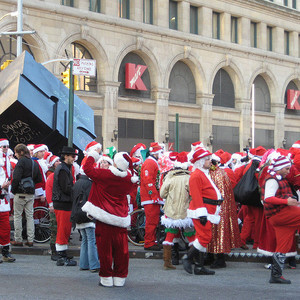Taxing imports makes imported goods more expensive for consumers. So why aren’t all seemingly similar items taxed the same? This audio story focuses on imported suits for Santa Claus impersonators. These red suits with white firm trim are worn by thousands of Santa Clauses around the Christmas holidays. Some of these outfits are taxed, others are not. Listen to learn more about the sometimes complicated laws that determine why not all Santa suits are taxed equally.
Listen to the story
ROBERT SIEGEL: Now a holiday story about a tariff dispute. And if anyone could come up with such a story it would be our Planet Money team. Here are Robert Smith and Jacob Goldstein.
JACOB GOLDSTEIN: Robert Smith, what are you wearing?
ROBERT SMITH, BYLINE: I am wearing red pants, a red overcoat, a black belt. I’m dressed as Santa.
GOLDSTEIN: What am I wearing?
SMITH: You are also wearing a Santa suit (laughter), something I never thought I’d see, Mr. Goldstein.
GOLDSTEIN: Me neither, but we are surrounded by – oh, I don’t know – 1,000 people dressed as Santa.
Robert and I are at SantaCon, this big, rolling Santa-themed party in New York City. We’re here because this is what that tariff dispute is over – Santa suits. Looking around, all these suits look pretty much the same. But according to the U.S. government, they are not. Santa suits, the government says, fall into two very different categories. Category one – flimsy, the cheap ones.
UNIDENTIFIED MAN #1: I’m trying to get my belt to work.
GOLDSTEIN: You’re having belt trouble?
UNIDENTIFIED MAN #1: Yes.
SMITH: Do you need our help with this, sir?
UNIDENTIFIED MAN #1: No, no. I’m OK. It was like a $14 Santa costume.
GOLDSTEIN: U.S. customs looks at this cheap $14 suit and says, this is a festive article. It’s in the same part of the tariff code as holiday decorations and party favors. A suit like this you can import duty-free, no tax. But then there’s a second category of Santa suits – nice ones, well-made.
UNIDENTIFIED MAN #2: It’s got a hood over it, long sleeves, some embroidering here.
GOLDSTEIN: Yeah, the embroidery is beautiful – gold embroidery. And, look, this looks like a real belt.
UNIDENTIFIED MAN #2: Oh, yeah.
GOLDSTEIN: U.S. customs looks at a suit like this and says, wait, this is so nice, it’s clothes. And to import clothes, you do have to pay a tariff, you do have to pay a tax.
Marc Beige thinks this is ridiculous. He, not surprisingly, is a big costume importer. He’s suing the government, saying, come on, Santa suits are not clothes.
MARC BEIGE: This is the epitome of a festive article. I mean, when else, other than Christmas, are you going to wear this?
GOLDSTEIN: I mean, it’s nice. I could put on this red, fur jacket.
BEIGE: Right, but when is the last time you went around dressed as a Santa Claus (laughter)?
GOLDSTEIN: So where should Santa suits go in the tariff? I called up an expert – Douglas Irwin, a professor at Dartmouth. And he seemed to have every tariff code ever written sitting there in his office. He says the tariff on clothes goes way back. It’s part of the second law ever passed by the U.S. Congress. The other category, festive articles, he had to dig for that one. Eventually he got to the tariff code from 1922.
DOUG IRWIN: Oh, I think festooning is festive articles.
GOLDSTEIN: OK.
IRWIN: Here’s what it says, (reading) doll heads, toy marbles, toy games, toy containers, toy favors, toy souvenirs, garlands, festooning, and Christmas tree decorations.
GOLDSTEIN: Nowhere in that list does it say Santa suits or costumes. But if you read through the part of the tariff code that covers clothes, that also does not mention Santa suits or costumes. The tariff code’s more than 3,000 pages long. It lists thousands of things. But you could never list everything, and costumes are just one of the things that’s not in there. Customs declined to comment for this story, but the government itself doesn’t seem to be sure where costumes belong. It’s changed its mind over the years about what goes where. And Marc Beige, the importer suing the government, he’s changed his mind, too.
You were on the other side then, right?
BEIGE: Absolutely.
GOLDSTEIN: Back in the ’90s, Marc Beige was not importing costumes. He was making them here, in the United States. That’s why he used to be on the other side. Now Beige and a group of costume importers are trying to end this fight once and for all. They’re trying to get Congress to pass a law saying costumes are festive articles, not clothes. If passed, the law would make that 3,000-page tariff code one paragraph longer. Jacob Goldstein, NPR News.
 © 2015 National Public Radio, Inc. Used with the permission of NPR. All rights reserved.
© 2015 National Public Radio, Inc. Used with the permission of NPR. All rights reserved. Vocabulary
- tariff – a tax paid on imports
- duty – a tax on imports
- duty-free – describes articles that can be imported without paying taxes
- customs – the government department that oversees taxes on imports
- epitome – a person or object (e.g., Santa suit) that is a perfect example of a quality or type
Listening Comprehension Questions
- What are the two types of Santa suits identified in the story?
- Which type is taxed, and which type is not taxed? Why?
- What tariff law has been used to tax one type of imported Santa suit?
- Why is Mark Beige suing the government?
- Why was Mark Beige on the other side of the argument in the 1990s?
Discussion Themes
- What is the difference between costumes and clothing? In which category or categories do you think Santa suits belong? Why?
- Based on what you heard, how would you resolve the lawsuit about Santa suit imports? Explain your answer.
Teacher’s Guide
Activate student knowledge: Open class by asking students what, if anything, they know about tariffs. If tariffs have been in the news, draw on current events to encourage their interest in the subject. Explain that tariffs are taxes on imports. When the United States taxes imported goods, the taxes are added to the cost of the goods, which then become more expensive to American consumers. So, import tariffs discourage people from importing certain products, giving an advantage to products made in the United States.
Introduce the story: In this audio story, you will hear about an unlikely controversy—one that involves Santa suits. Depending on how you interpret the tariff code, imported Santa suits may or may not be taxed. Listen to find out why there is all this fuss about Santa’s clothes and what this amusing example can teach us about tariffs.
Active listening supports: Choose one of the following listening organizers to support student understanding as they listen to the story.
- The Fill in the Blank worksheet will inform students’ comprehension as they examine the story.
- The Language Identification organizer allows students to follow along and track important phrases while listening to the story.
Reflect on the story: Take time for student reflection on the audio story and discussion questions to check for understanding. Focus on students understanding of why tariffs are imposed, who favors them, and who opposes them.
Paired Text: Use the article Tariffs, Their Pros and Cons, With Examples to pair with this audio story. The article provides useful information that explains what tariffs are, why countries impose them, and their benefits and drawbacks. Have students use this information to contextualize the debate about tariffs on Santa suits.


